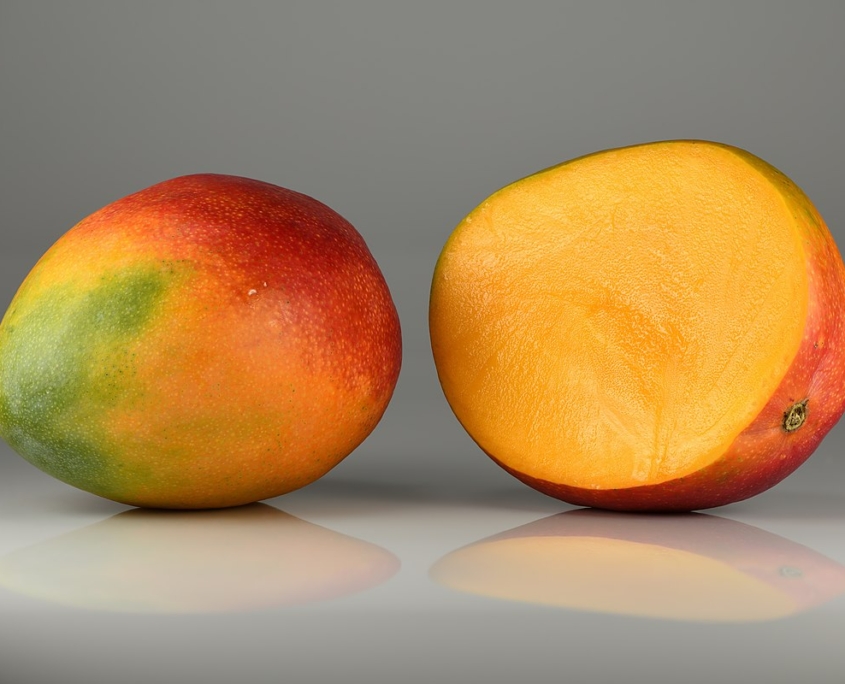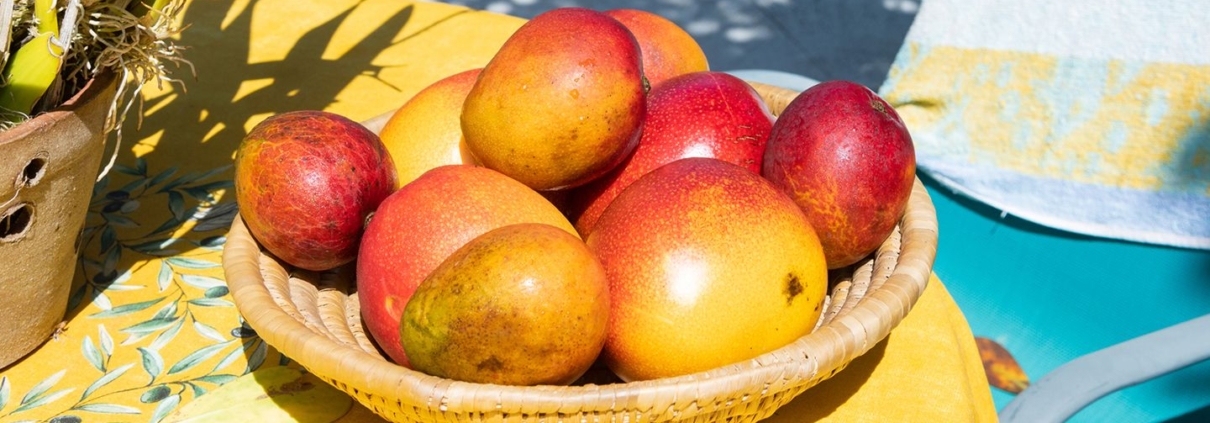Explore Mango Fruit Magic – The Sweet Talk of Tropical Mango Fruits
Table of Contents
ToggleMango Fruit
Mangoes, often referred to as the “king of fruits,” are not just a tropical delight; they embody a burst of flavor, nutrition, and cultural significance. Here, we explore the various facets of the beloved Mango Fruit, from its tantalizing taste to its health benefits and the cultural richness it brings to diverse communities.

1. A Symphony of Flavor:
Mangoes are renowned for their exceptional taste and fragrance. The succulent flesh of a ripe Mango Fruit is a harmonious blend of sweetness and tanginess, offering a sensory experience that captivates taste buds. The flavor profile varies among different mango varieties, ranging from the rich, honey-like sweetness of Alphonso mangoes to the milder, citrusy notes of Ataulfo mangoes.
2. Nutritional Powerhouse:
Beyond their delectable taste, Mango Fruits pack a nutritional punch. They are a rich source of vitamins, particularly vitamin C and vitamin A, essential for immune health and vision. Mangoes also provide fiber, promoting digestive health, and are loaded with antioxidants that help combat oxidative stress in the body.
3. Versatile Culinary Companion:
Mangoes lend themselves to a myriad of culinary creations. Whether enjoyed fresh in salads, blended into smoothies, or incorporated into both savory and sweet dishes, Mango Fruits add a tropical flair to the kitchen. From mango salsas to mango lassi, the possibilities are as diverse as the cultures that celebrate this fruit.
4. Cultural Significance:
Mangoes hold a special place in the heart of many cultures around the world. In some regions, the arrival of mango season is marked by festivals and celebrations, highlighting the cultural significance of this fruit. It is often seen as a symbol of prosperity, abundance, and good fortune.
5. Growing Regions:
Mango trees thrive in tropical and subtropical climates. Major mango-producing countries include India, China, Thailand, Indonesia, and the Philippines. The diverse climate conditions contribute to the array of mango varieties available, each with its own distinct flavor and characteristics.
6. Varieties of Mangoes:
There are hundreds of mango varieties, each with its unique taste, texture, and color. Some globally celebrated varieties include Alphonso, Haden, Kent, Tommy Atkins, and Keitt. The choice of variety depends on factors such as regional availability and personal preference.
7. Ripening and Selection:
Mangoes are typically harvested when mature but still firm. The ripening process continues off the tree, and ripe mangoes yield slightly to gentle pressure. The skin color is not always indicative of ripeness, as it varies with the variety. To enhance ripening, store mangoes at room temperature, and refrigerate once ripe to prolong freshness.
In essence, the Mango Fruit is more than just a tropical treat. It’s a symbol of vibrant flavors, healthful benefits, and a rich cultural tapestry. Whether enjoyed fresh, blended, or as part of culinary creations, the Mango Fruit continues to captivate hearts and taste buds, making it a truly cherished fruit around the globe.
Savoring the Sweetness: Afrisun Orchards, Your Go-To for the Best Mango Fruit in Kenya
In the heart of Kenya’s sun-soaked landscapes, a delightful tale unfolds—the story of Mango Fruits and our journey at Afrisun Orchards, where the sun, soil, and care come together to create something truly special.

Mango Magic: From Blossom to Bite
Our Mango Fruits, known as the “King of Fruits,” start their journey in our orchards, soaking up the Kenyan sun and the essence of our unique land. When spring arrives, delicate blossoms appear, marking the beginning of a magical transformation. As these blossoms turn into tiny green fruits, we put all our love and care into ensuring they grow to embody the fullness of flavor and sweetness.
Exporting Joy: Afrisun Orchards Takes the Lead
We don’t just grow mangoes; we champion them to global heights. As the best Mango Fruit exporter in Kenya, we hold ourselves to the highest standards. We carefully harvest our fruits at their peak, when the colors, aroma, and taste come together in perfect harmony. Our state-of-the-art facilities ensure that only the finest mangoes make their way to markets around the world.
Global Recognition: Our Mangoes Take Center Stage
Our Mango Fruits have earned acclaim globally. Our commitment to excellence and sustainable practices has made us a trusted supplier in the international market. People all over the world get to savor the taste of Kenya’s finest mangoes, fresh and flavorful, thanks to our expertise.
Cultivating Quality and Community
Beyond being a leader in Mango Fruit exports, we are deeply rooted in community development and environmental stewardship. Our initiatives uplift local communities, creating a positive and sustainable impact. We believe in growing more than just mangoes; we grow well-being for people and the planet.
Nurturing Nature: Our Eco-Friendly Practices
At Afrisun Orchards, we take pride in our eco-friendly practices. From organic fertilizers to water conservation efforts, we strive to minimize our environmental impact. Our sustainable approach ensures that future generations can enjoy the richness of our land, just as we do today.
From Orchard to Table: The Joyful Journey of Our Mangoes
The journey doesn’t end at the orchards. From the moment our Mango Fruits are harvested, we ensure they make their way to your table with utmost care. We want you to experience not just the taste of our mangoes but the love and dedication we pour into every juicy, sun-kissed piece of fruit.
In conclusion, the journey of our Mango Fruits, enriched by the expertise of Afrisun Orchards, is a testament to the marriage of nature’s bounty and our dedication. As your go-to for the best Mango Fruit in Kenya, we not only deliver a taste of tropical paradise to your table but also share the joy and care that go into every juicy, sun-kissed mango we produce.
The Journey of a Mango Fruit: A Tale of Growth, Ripening, and Cultural Delight
The enchanting life cycle of a Mango Fruit unfolds in a series of stages, each contributing to the vibrant, succulent delight that graces our tables. From the delicate blossoming of the mango tree to the final, juicy harvest, the Mango Fruit undergoes a captivating transformation that is both a marvel of nature and a testament to the tree’s resilience. Let’s delve deeper into the intricacies of each stage, exploring the cultural significance and global impact of this beloved fruit.

Stage 1: Flowering and Pollination
The story commences with the mango tree’s graceful adornment in spring, as clusters of small, aromatic flowers emerge. These blossoms play a pivotal role in the Mango Fruit’s journey, serving as the starting point for its growth. Through the assistance of insects or the wind, pollination occurs, setting the stage for the magical transformation from flower to fruit. This stage not only marks the beginning of the Mango Fruit but also contributes to the biodiversity of the surrounding environment.
Stage 2: Fruit Setting
Once successfully pollinated, the mango flowers metamorphose into tiny green fruits. In their infancy, these fruits are barely discernible among the verdant foliage of the tree. The mango tree invests considerable energy in nurturing these nascent fruits, providing them with the essential nutrients and water required for the next stage of development. This stage is a testament to the mango tree’s role as a provider, sustaining life and ensuring the continuation of its lineage.
Stage 3: Fruit Enlargement
As the Mango Fruit matures, it undergoes a phase of rapid enlargement. The once diminutive green fruit starts to gain size and weight. This stage marks the emergence of the Mango Fruit’s characteristic shape, be it oval or slightly kidney-shaped. The green hue deepens, offering a preview of the delectable sweetness that will soon unfold. In many cultures, this stage is associated with anticipation and the promise of a bountiful harvest.
Stage 4: Ripening
The most eagerly anticipated phase in the Mango Fruit’s growth is its ripening. The fruit continues to enlarge, and its color transitions from green to various shades of yellow, orange, or red, depending on the mango variety. The flesh inside softens, and the distinctive aroma becomes more pronounced. This stage is a testament to the tree’s dedication to producing a mature, flavorful Mango Fruit. Ripening is not just a biological process; it is a sensory experience that captivates the senses and signals the fruit’s readiness for consumption.
Stage 5: Harvesting
Once fully ripe, the Mango Fruit is ready for harvesting. This delicate process requires precision, as the fruit must be picked at the right moment to ensure optimal flavor and texture. The act of harvesting signals the culmination of months of growth and development, as the Mango Fruit is carefully plucked from the tree, ready to embark on its journey to our tables. Harvesting is a labor-intensive activity that often involves communities coming together, creating a sense of shared effort and celebration.
Stage 6: Enjoyment
The final chapter in the Mango Fruit’s journey is the joyous moment of consumption. Whether enjoyed fresh, sliced into salads, blended into smoothies, or incorporated into various culinary creations, the Mango Fruit’s sweetness and juiciness are a feast for the senses. This stage is the ultimate reward for the meticulous care and natural processes that have transformed a delicate flower into a succulent, ripe fruit. In many cultures, the Mango Fruit holds a symbolic significance, representing abundance, prosperity, and the sweetness of life.
In essence, the growth of a Mango Fruit is a mesmerizing tale that showcases the wonders of nature. From the humble beginnings of a flower to the delectable end product, the Mango Fruit’s journey is a celebration of life, growth, and the bountiful gifts that nature graciously provides for our enjoyment. As we savor each bite of this tropical delicacy, we not only indulge in its sweetness but also partake in a cultural tradition that spans generations and connects communities worldwide. The Mango Fruit is not merely a fruit; it is a symbol of nature’s generosity and a source of shared joy and delight across the globe.
Mango Mastery: Expert Tips for Growing Amazing Mango Fruits

Cultivating and maintaining a healthy mango tree is key to ensuring a bountiful harvest of delicious Mango Fruits. Whether you’re a seasoned gardener or a novice, here are some essential maintenance tips to help you nurture your mango tree and enjoy the sweet rewards of a thriving harvest:
-
Selecting the Right Variety:
- Choose a mango tree variety that is well-suited to your climate. Different varieties thrive in different conditions, so it’s crucial to select one that matches your local weather and soil type.
-
Planting Location:
- Mango trees prefer a sunny, well-drained location. Ensure that your planting site receives at least 6 to 8 hours of sunlight each day. Adequate sunlight is essential for flowering and fruiting.
-
Soil Preparation:
- Plant your mango tree in well-draining soil with a slightly acidic to neutral pH. Amending the soil with organic matter, such as compost, can improve fertility and drainage.
-
Watering:
- Young mango trees require regular watering to establish their root systems. Once established, mango trees are relatively drought-tolerant. Water consistently, especially during dry spells, and avoid waterlogged conditions.
-
Mulching:
- Apply a layer of organic mulch around the base of the tree to help retain soil moisture, suppress weeds, and regulate soil temperature. Mulching also adds valuable organic matter to the soil as it breaks down.
-
Fertilization:
- Mango trees benefit from regular fertilization, especially during the growing season. Use a balanced fertilizer with micronutrients, and follow recommended application rates. Reduce fertilizer in the fall and winter when the tree is dormant.
-
Pruning:
- Prune your mango tree to maintain a balanced shape, remove dead or diseased branches, and improve air circulation. Pruning also helps manage the tree’s height, making it easier to harvest the fruit.
-
Pest and Disease Management:
- Monitor your mango tree regularly for signs of pests and diseases. Common issues include anthracnose, scale insects, and aphids. Use organic or chemical control methods as needed, and address problems promptly to prevent them from spreading.
-
Thinning Fruit:
- In cases where your mango tree sets an abundance of fruit, consider thinning the fruit when they are still small. This practice helps redirect the tree’s energy to fewer fruits, resulting in larger and higher-quality Mango Fruits.
-
Harvesting:
- Harvest Mango Fruits when they are fully ripe but still firm. Gently twist or cut the fruit from the tree, taking care not to damage the stem or surrounding fruit. Allow harvested fruits to ripen further indoors, if necessary.
-
Post-Harvest Care:
- After harvesting, continue to care for your mango tree by providing appropriate water and nutrients. This ensures the tree’s health and prepares it for the next growing season.
By following these maintenance tips, you can foster the optimal growth of your mango tree and enjoy a plentiful harvest of delectable Mango Fruits. Remember to adapt these guidelines to your specific local conditions and the unique needs of your mango tree variety.



